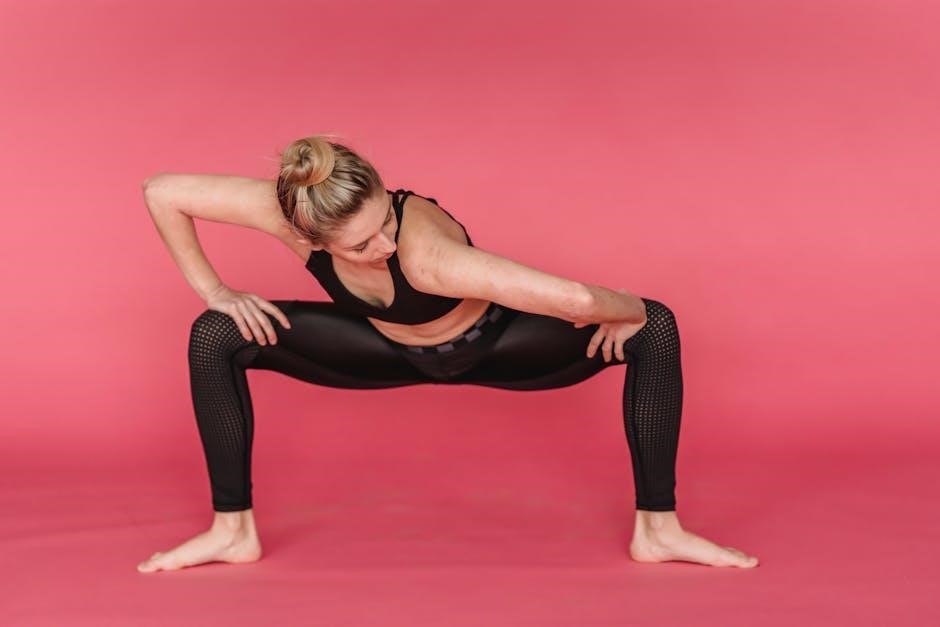
bra fitting guide
Proper bra fitting is essential for comfort, confidence, and overall well-being․ This guide offers step-by-step instructions to help you find your perfect fit and enhance your daily life․
Why Proper Bra Fit Matters
A well-fitting bra is crucial for both comfort and health․ Poorly fitting bras can cause discomfort, back pain, and even long-term damage to skin and muscles․ A proper fit ensures optimal support, enhances confidence, and improves posture․ It also prevents issues like digging straps or band irritation, which can disrupt daily activities․ Additionally, the right fit flatters body shape and ensures clothing fits better․ Measuring correctly and understanding personal needs are key to finding a bra that promotes well-being and self-assurance․ Regular check-ins and updates to size ensure continued comfort and support as the body changes over time․
The Importance of a Well-Fitting Bra
A well-fitting bra provides essential support, preventing back and shoulder pain while enhancing posture․ It distributes weight evenly, reducing strain on muscles and improving comfort․ Proper fit also boosts confidence, allowing freedom of movement and ensuring clothing fits seamlessly․ Different bra styles cater to various needs, whether for daily wear, sports, or special occasions․ A good fit minimizes discomfort and maximizes functionality, making it a vital part of a comfortable wardrobe․ By understanding personal measurements and needs, individuals can choose bras that offer both support and style, ensuring all-day comfort and confidence in every situation they encounter․
Overview of the Bra Fitting Process
The bra fitting process involves measuring band and bust sizes to determine accurate measurements․ It starts with wrapping a tape measure around the ribcage for the band size, ensuring it’s snug but not tight․ Next, the bust is measured around the fullest part, with the tape level and not compressing the breasts․ The cup size is calculated by subtracting the band size from the bust size․ Using a bra size calculator can confirm the fit․ Proper fit checks involve ensuring the band stays in place, cups cover the breasts fully, and straps adjust without digging․ This process ensures comfort, support, and a flattering appearance, making it crucial for selecting the right bra․
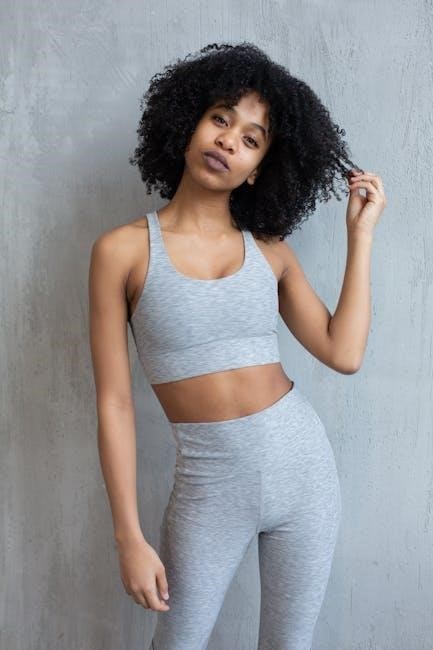
How to Measure Your Bra Size
Measuring your bra size involves calculating band and bust sizes using a tape measure․ This ensures a comfortable and supportive fit, enhancing your overall bra-wearing experience․
Step 1: Measure Your Band Size
Wrap a measuring tape around your ribcage, just below your bust, ensuring it’s level and not too tight․ The tape should be snug, allowing two fingers to fit comfortably underneath․ If the measurement is an odd number, round up to the nearest even number to determine your band size․ This step is crucial as the band provides most of the bra’s support․ A well-fitting band ensures comfort and prevents issues like digging or riding up․ Proper measurement here sets the foundation for a accurate bra size calculation․
Step 2: Measure Your Bust Size
Place the measuring tape around the fullest part of your bust, keeping it level and parallel to the floor․ Ensure the tape isn’t too tight or too loose․ This measurement helps determine your cup size when compared to your band size․ Proper alignment is key; the tape should skim the bra in front if you’re wearing one․ For accuracy, take a deep breath and relax your shoulders․ If using a string, mark the point and measure its length with a ruler․ This step ensures your cups fit comfortably, preventing gapping or spillage for optimal support and confidence․
Step 3: Determine Your Cup Size
Subtract your band size from your bust measurement to find your cup size․ For example, if your bust is 37 inches and your band is 34 inches, the difference is 3 inches, corresponding to a C cup․ Use a bra size chart to match your difference to the correct cup size․ Ensure accuracy by using a consistent method, whether with a tape measure or a string․ This calculation helps you identify the right cup size for a flattering and supportive fit, ensuring your bra feels comfortable and looks great; Proper cup fit is crucial for both aesthetics and functionality․
Step 4: Use a Bra Size Calculator
A bra size calculator simplifies the process by converting your band and bust measurements into your bra size․ Enter your band size and bust size, and the calculator will determine your cup size․ For example, if your band is 34 and your bust is 37, the calculator will show a 34C․ This tool ensures accuracy and saves time․ Many calculators also offer sister size options if your band or cup size doesn’t fit perfectly․ Double-check your measurements for precision, as small errors can affect results․ Using a calculator is a convenient way to confirm your size before shopping․ It’s a reliable shortcut for finding your ideal fit․ Always verify the calculator’s accuracy for consistent results․
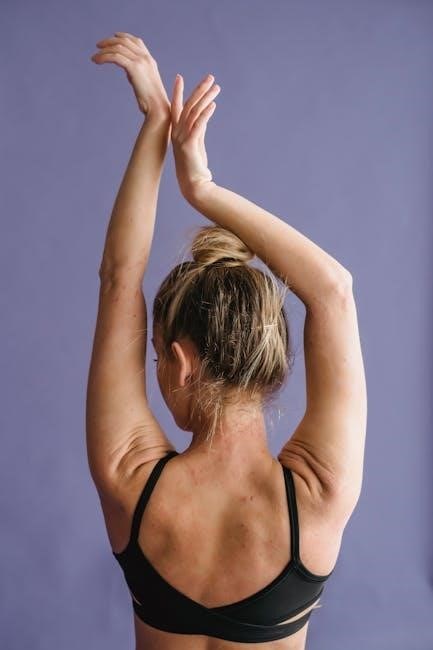
Understanding Bra Fit
Proper bra fit is foundational for comfort and confidence․ It ensures the band supports your torso, cups encapsulate your breasts, and straps distribute weight evenly․ A well-fitting bra enhances posture and overall well-being, making it easier to move freely․ Understanding your fit helps you identify styles that suit your body, addressing comfort and aesthetics․
Signs of a Perfectly Fitting Bra
A perfectly fitting bra provides comfort and support without discomfort․ The band should sit snugly around your torso, staying in place without digging or riding up․ The cups should fully encapsulate your breasts, with no spillage or gapping․ Straps should rest evenly on your shoulders, offering stability without causing pain or indentations․ The bra should lie flat against your body, with no wires poking or digging․ Proper fit ensures your posture improves and movement feels unrestricted․ If your bra meets these criteria, it’s a sign of an ideal fit, allowing you to feel confident and comfortable throughout the day․ Always prioritize these signs for the best experience․
Common Bra Fit Issues and Solutions
Identifying and addressing common bra fit issues can significantly enhance comfort and support․ One prevalent problem is a band that rides up, indicating a too-small size; try a larger band size․ Gaping cups suggest the cup size is too big, so opt for a smaller cup․ Straps that dig into shoulders may mean the band is too loose or the cup size is incorrect․ Adjust the band to a snugger fit and ensure straps are not over-tightened․ For underwire discomfort, consider a wireless bra or a different style․ Regularly measuring and updating your size helps prevent these issues, ensuring a better fit and overall satisfaction․

How to Check for Proper Support
Ensuring proper support is crucial for both comfort and health․ When checking your bra, the band should provide most of the support, sitting level and snug without digging․ The cups should fully encase your breasts without gaping or spilling over․ Straps should rest comfortably on your shoulders, adjusting to distribute weight evenly․ A well-supported bra prevents back pain and promotes good posture․ If the bra feels restrictive or if you notice red marks, it may be too tight․ Regularly assess the fit to maintain optimal support and adjust as needed for lasting comfort and confidence․ Proper support enhances both functionality and appearance, making it a key aspect of bra fitting․
Adjusting Your Bra for the Best Fit
Adjusting your bra ensures optimal comfort and support․ Start by hooking the band on the loosest setting to allow for stretch over time․ Tighten the straps gradually until they sit comfortably on your shoulders without digging․ Ensure the cups fully cover your breasts, with no gaps or overflow․ For underwire bras, the wire should lie flat against your sternum, not pressing into your skin․ If the bra rides up, the band may be too loose․ Regular adjustments maintain the best fit and prevent discomfort․ Properly adjusted bras provide all-day support, enhancing your posture and confidence while minimizing the risk of back pain and skin irritation․
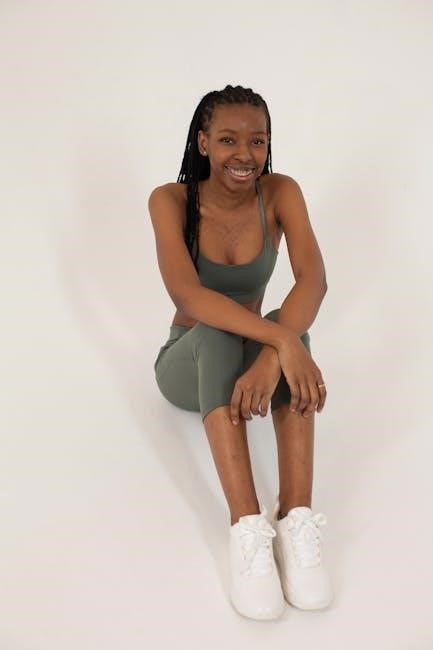
Bra Components and Their Impact on Fit
Understanding bra components is key to achieving a flattering fit․ The band, cups, straps, and underwire each play a role in providing support and comfort, ensuring a perfect fit that enhances your natural shape while maintaining a seamless look under clothing․
Understanding the Parts of a Bra
A bra consists of several key components that work together to provide support and comfort․ The band is the foundational part that wraps around the torso, offering the majority of support․ The cups are designed to hold and shape the breasts, available in various styles such as molded, seamless, or lace․ The straps adjust to ensure proper placement and balance, while the underwire adds additional structure for larger busts․ The closure at the back ensures a secure fit, and seams contribute to the overall shape and durability․ Each part plays a crucial role in achieving a comfortable and flattering fit․
Different Types of Bras and Their Fits
Various bra styles cater to different needs and preferences․ T-shirt bras are seamless and offer a smooth look under tight clothing․ Wireless bras provide comfort without underwire support, ideal for everyday wear․ Sports bras are designed for active lifestyles, offering high-impact support․ Push-up bras enhance cleavage, while strapless bras are perfect for off-the-shoulder outfits․ Minimizer bras reduce bust appearance, and mastectomy bras cater to post-surgery needs․ Each type ensures a tailored fit, addressing specific body types and activities․ Understanding these options helps in selecting the most suitable bra for comfort and confidence․
The Role of Underwire vs․ Wireless Bras
Underwire bras feature a wire that surrounds the bottom of the breast, providing additional support and shape․ They are ideal for larger busts or those seeking more defined separation․ In contrast, wireless bras eliminate the underwire, offering a more relaxed fit․ Wireless bras are perfect for smaller busts or for women seeking comfort without sacrificing style․ Both styles cater to different preferences and needs, ensuring optimal support and comfort․ Choosing between them depends on personal comfort, lifestyle, and the level of support required․ Understanding their benefits helps in making informed decisions for the best fit․
Strap and Band Adjustability
Adjustable straps and bands are key to achieving a personalized fit․ Straps can be tailored to suit shoulder comfort, while bands provide the majority of support․ Ensuring the band fits snugly yet comfortably is crucial, as it should allow two fingers to slide under easily․ Over time, bands stretch, so having multiple adjustment hooks ensures longevity․ Properly fitted straps prevent digging or slipping, enhancing overall comfort․ Regular adjustments maintain optimal support and prevent issues like back pain․ The flexibility of these features ensures a bra adapts to your body, providing lasting comfort and confidence throughout the day․ This adaptability is essential for a perfect fit․
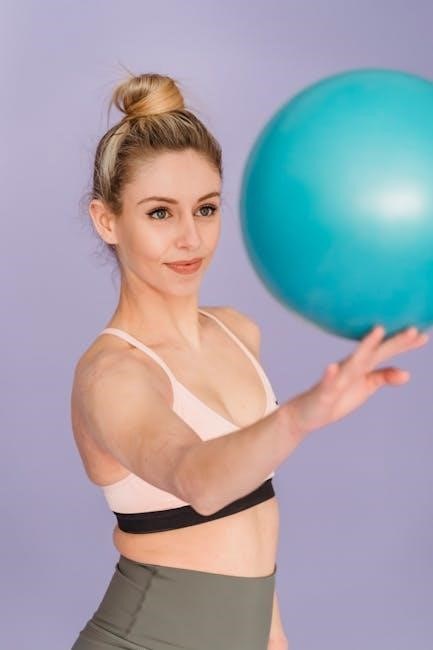
Specialized Bra Fitting Needs
Addressing unique needs like plus-size, pregnancy, and back fat reduction ensures comfort and support for all body types, enhancing confidence and promoting a positive body image․
Fitting Bras for Different Body Types
Finding the right bra for your body type ensures maximum comfort and support․ For petite frames, demi or balconette styles work well, while fuller busts benefit from structured bras․ Pear-shaped bodies may prefer wide straps for better distribution, and hourglass figures often find underwire bras ideal․ Plus-size individuals should look for bras with reinforced bands and side boning․ Understanding your silhouette helps in selecting styles that flatter and provide optimal support, ensuring a seamless fit tailored to your unique shape and needs․
Plus-Size Bra Fitting Tips
Minimizing Back Fat with the Right Bra
Choosing the right bra can help reduce the appearance of back fat․ Opt for styles with wide, breathable bands and adjustable straps to ensure a secure fit․ Bras with reinforced side panels or boning provide additional support and smooth out the back․ Consider seamless or contour bras that create a sleek silhouette․ Ensure the band sits level and isn’t too tight, as this can cause bulging․ Properly fitted bras with a snug band and supportive features can enhance comfort and create a more streamlined look․ Regularly updating your bra wardrobe ensures the best fit and support․
Bra Fitting for Pregnant or Nursing Women
Pregnancy and nursing bring significant changes to a woman’s body, requiring specialized bras․ During pregnancy, a supportive, wire-free bra with a stretchy band is ideal for comfort․ Look for soft cups and adjustable straps to accommodate growing breasts․ Postpartum, nursing bras with easy one-handed clasps and breathable fabrics are essential․ Proper fit ensures comfort and prevents issues like clogged ducts․ Experts recommend frequent size checks as breasts change during and after pregnancy․ Opt for bras with multiple hook settings to adjust as needed․ These features ensure both comfort and functionality, supporting mothers through each stage․
Bra Size Conversion and Sister Sizes
Understanding bra size conversion and sister sizes helps find your perfect fit across brands and regions․ Sister sizes offer the same cup capacity with different band sizes, ensuring comfort and support․
Understanding Bra Size Conversion Charts
Bra size conversion charts are essential for navigating the differences in sizing across brands and regions․ These charts help translate your bra size into equivalent sizes for various countries, ensuring a consistent fit․ They also clarify sister sizes, which maintain the same cup volume but adjust the band size․ For example, a 34C and a 36B are sister sizes․ Handy charts simplify finding your size, whether shopping internationally or exploring different brands․ Understanding these conversions empowers you to find the perfect fit, enhancing comfort and confidence․ Regularly updating your measurements and considering breast shape ensure the best results from these tools․
What Are Sister Sizes?
Sister sizes are bra sizes that share the same cup volume but differ in band size․ For instance, a 34C and a 36B are sister sizes, as the cup capacity remains consistent while the band adjusts․ This concept is crucial when your current bra fits well in the cups but not the band․ By exploring sister sizes, you can achieve a more comfortable and supportive fit without compromising on style or functionality․ They are especially useful during weight changes or when trying new brands, ensuring you maintain the right proportions for optimal comfort and confidence․ Sister sizes help you find the perfect balance in fit and support․
How to Find Your Sister Size
To find your sister size, start by identifying your current bra size․ If the band fits but the cups are too small, try a larger band size with a smaller cup․ Conversely, if the band is too tight but the cups fit, opt for a smaller band with a larger cup․ For example, if you wear a 34C and need a looser band, your sister size could be a 36B․ Use a sister size chart to navigate these adjustments easily․ This ensures the same cup volume while refining the band for a more comfortable and supportive fit․ Experimenting with sister sizes can help you achieve the perfect balance in your bra fit․
When to Consider a Sister Size
Consider a sister size when your current bra band or cups don’t fit perfectly․ If the band is too tight but the cups fit, or the band is too loose but the cups are too small, a sister size can offer a better fit․ Sister sizes maintain the same cup volume but adjust the band size, ensuring comfort and support․ For instance, if a 34C feels restrictive, a 36B might provide the right balance․ This adjustment is particularly useful during body changes, such as weight fluctuations or pregnancy, when bra size needs may shift temporarily․ Exploring sister sizes can enhance both comfort and confidence in your bra choice․
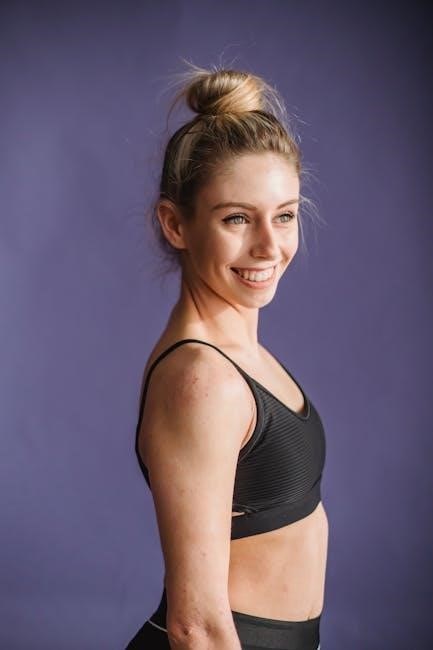
Breast Shape and Bra Fit
Breast shape significantly impacts bra fit․ Understanding your shape helps choose styles that flatter and support, ensuring comfort and confidence in every outfit․
Identifying Your Breast Shape
Understanding your breast shape is crucial for optimal bra fit․ Common shapes include round, East-West, teardrop, and conical․ Round breasts are full and symmetrical, while East-West breasts point outward․ Teardrop breasts are fuller at the bottom, and conical breasts are narrow and pointed․ To identify your shape, observe the overall contour and how they sit on your chest․ Round breasts are the most common and typically fit standard bra styles well․ East-West breasts may benefit from bras with wider straps or side support․ Teardrop and conical shapes often find comfort in soft-cup or wireless bras․ Knowing your shape helps you choose styles that enhance comfort and support, ensuring a flattering and secure fit․
Best Bra Styles for Different Breast Shapes
Choosing the right bra style for your breast shape enhances comfort and flatters your silhouette․ For round breasts, push-up or balconette bras create definition․ East-West breasts benefit from wide straps or side-support bras to center them․ Teardrop-shaped breasts find comfort in soft-cup or wireless bras, while conical breasts look great in plunge or lace styles․ Asymmetrical breasts may prefer molded cups for balance․ Understanding your shape helps you select bras that offer the best support and aesthetic appeal, ensuring a confident and comfortable fit․ Experiment with styles to find what works best for your unique shape and personal preferences․
How Breast Shape Affects Fit
Breast shape significantly influences how a bra fits․ Round breasts may require more structured cups, while east-west breasts benefit from center-gore support․ Teardrop-shaped breasts often find comfort in soft-cup bras, whereas conical breasts may prefer underwire for definition․ Asymmetrical breasts can cause uneven fit, necessitating specialized styles․ The shape determines the bra’s ability to provide support and comfort, making it crucial to understand your breast type for optimal fit․ Each shape has unique needs, so choosing the right style ensures proper support and enhances overall comfort throughout the day․
Customizing Your Bra Wardrobe
Customizing your bra wardrobe ensures versatility and comfort for every occasion․ Consider owning a mix of styles like strapless, wireless, and sports bras to suit different outfits and activities․ For casual wear, opt for soft bralettes, while structured bras provide essential support for formal attire․ Tailor your collection based on your breast shape—teardrop breasts may prefer soft cups, while round breasts benefit from molded styles․ Rotate bras to extend their lifespan and replace them when they show signs of wear․ Proper care, like washing in mesh bags and avoiding high heat, maintains their shape and support․ A well-curated wardrobe enhances confidence and ensures the perfect fit for any situation․
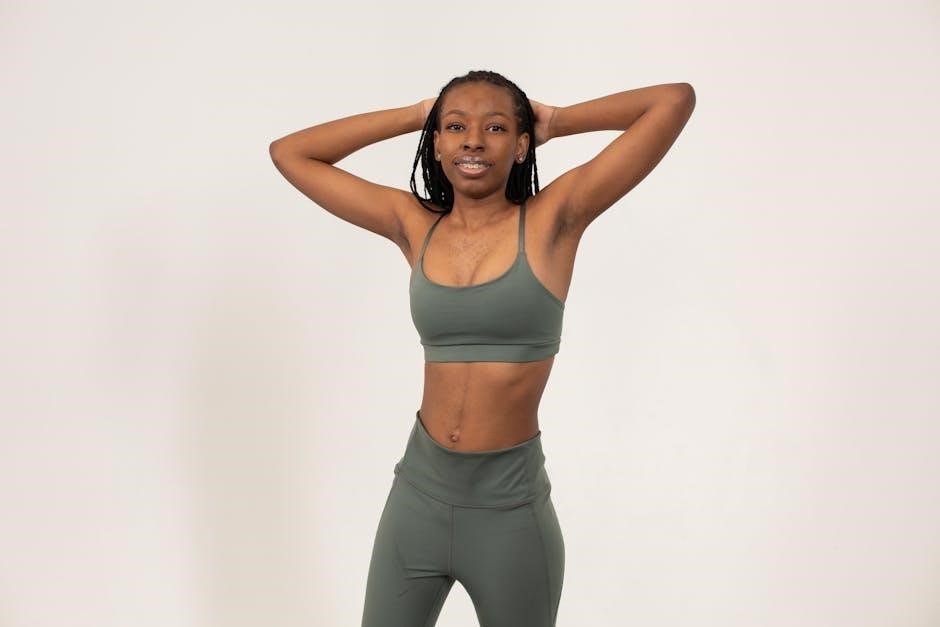
Caring for Your Bras
Proper care extends bra lifespan․ Wash in a mesh bag on delicate cycles, avoid high heat, and air dry․ Store bras to maintain shape and replace when elasticity fades or bands stretch․
How Often to Replace Your Bras
Bras typically need replacing every 6-12 months, depending on wear and tear․ Signs your bra is past its prime include stretched bands, sagging cups, or digging straps․ If it no longer provides adequate support or rides up, it’s time for a new one․ Proper care can extend longevity, but elasticity naturally degrades․ Replace your bras when they show visible wear or lose shape․ Wash them in a mesh bag, avoid high heat, and air dry to maintain condition․ Regular replacements ensure continued comfort and support, while also preventing potential discomfort or skin irritation from worn-out undergarments․
Proper Washing and Drying Techniques
Washing your bras in a mesh laundry bag on a delicate cycle with cold water preserves their shape and elasticity․ Avoid using harsh detergents or fabric softeners, as they can break down materials․ Gently agitate by hand or use a soft cycle to prevent damage․ After washing, reshape bras while damp and air-dry them away from direct sunlight․ Never wring or twist, as this can stretch the fabric․ High heat from dryers can destroy elastic fibers, so always air-dry․ Proper care ensures bras maintain their support and comfort, extending their lifespan and keeping them looking their best․
Storing Bras to Maintain Shape
Proper storage is key to maintaining the shape and quality of your bras․ Store them in a cool, dry place, away from direct sunlight to prevent fading․ Avoid folding or compressing bras, as this can distort their structure․ Instead, lay them flat or hang them by the straps using wide, padded hangers to avoid stretching․ For travel, place bras in protective cases to prevent creasing․ Consider organizing your collection in a drawer with dividers to prevent tangling․ By storing bras correctly, you preserve their fit, extend their lifespan, and ensure they remain comfortable and supportive for years to come․
Extending the Life of Your Bras
To extend the life of your bras, wash them gently by hand or use a delicate cycle with cold water․ Avoid using fabric softeners, as they can reduce elasticity․ Air-dry bras flat or lay them on a clean towel, never exposing them to direct sunlight or heat․ Regular wear rotation is crucial; alternating between bras allows fibers to recover․ Inspect bras regularly for signs of wear, such as frayed straps or stretched bands, and replace them when necessary․ Proper care and attention can significantly prolong the life of your bras, ensuring they remain supportive and comfortable for a longer period․
Additional Resources
Explore video tutorials, bra size calculators, and detailed fitting guides to enhance your understanding of bra sizing and care, ensuring you find the perfect fit effortlessly․
Online Bra Size Calculators
Online bra size calculators are invaluable tools for determining your accurate measurements․ These calculators guide you through a step-by-step process, using your band and bust measurements to find your perfect fit․ Many calculators, like the Liza Clifford Bra Size Calculator, ensure precision by accounting for subtle differences in size․ They often include tips for measuring at home, such as using a string or ribbon if a tape measure isn’t available․ Some calculators also offer sister size options, helping you find alternative sizes with the same cup capacity․ By leveraging these resources, you can confidently determine your size and explore styles tailored to your needs, ensuring both comfort and support․
Video Tutorials for Bra Fitting
Video tutorials are an excellent way to master the art of bra fitting from the comfort of your home․ These visual guides provide step-by-step instructions on how to measure your band and bust sizes, determine your cup size, and identify signs of a perfect fit․ Many tutorials, such as those from experts like Emma Seymour, also demonstrate how to check for proper support and adjust your bra for optimal comfort․ Additionally, videos often cover common fit issues and solutions, helping you troubleshoot problems like gapping cups or a too-tight band․ By following these tutorials, you can gain confidence in finding your ideal bra size and style․
Bra Fitting Guides and Charts
Bra fitting guides and charts are invaluable tools for determining your correct size and ensuring a comfortable fit․ These resources often include detailed step-by-step instructions, measurement charts, and size conversion tables to help you navigate the complexities of bra sizing․ Many guides, such as those from Good Housekeeping, provide handy charts that simplify the process of finding your band and cup sizes․ Additionally, charts for sister sizes and international size conversions are particularly useful for those who struggle with standard sizing․ By using these guides, you can confidently identify your ideal fit and explore various bra styles suited to your body type and preferences․